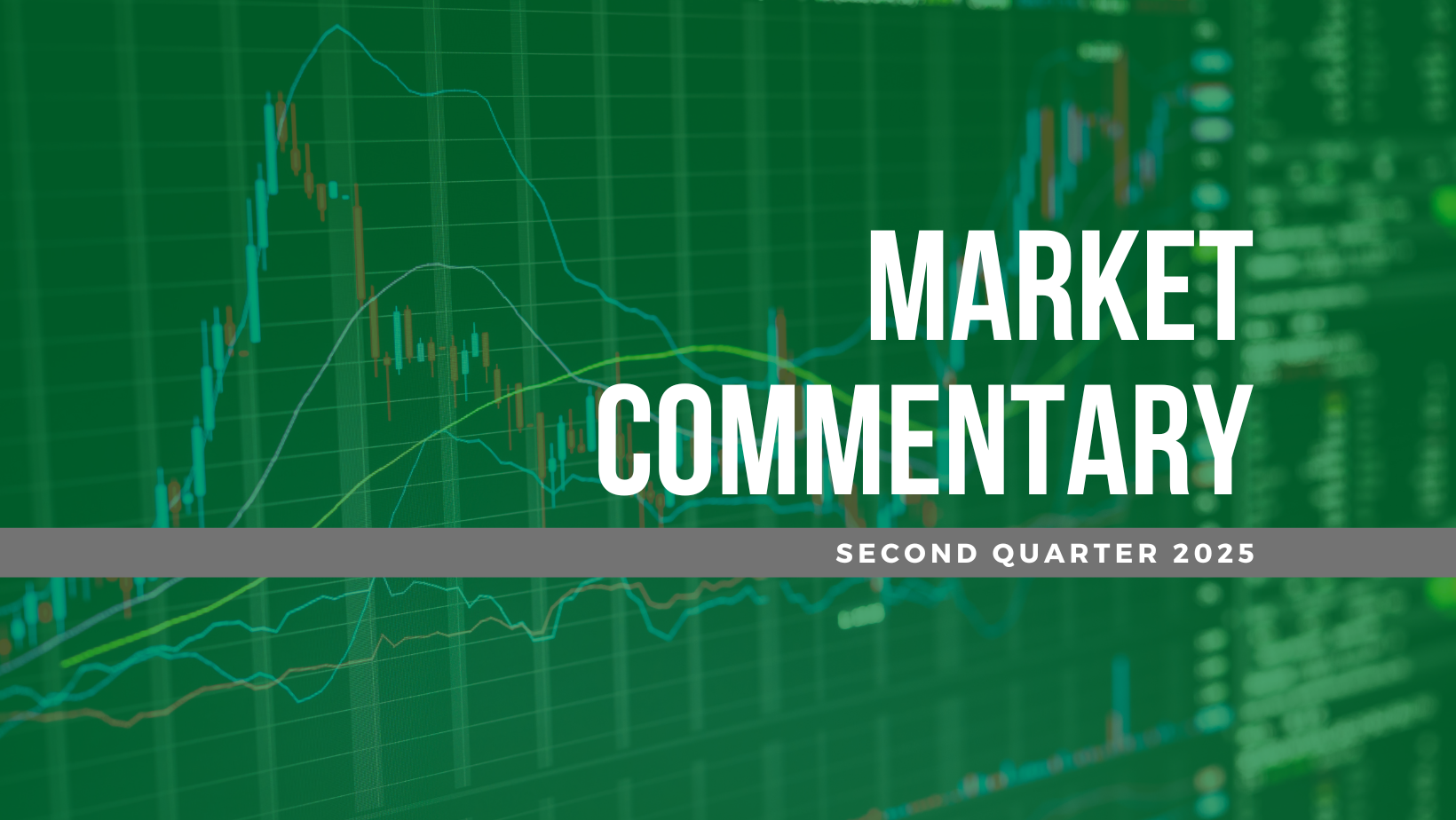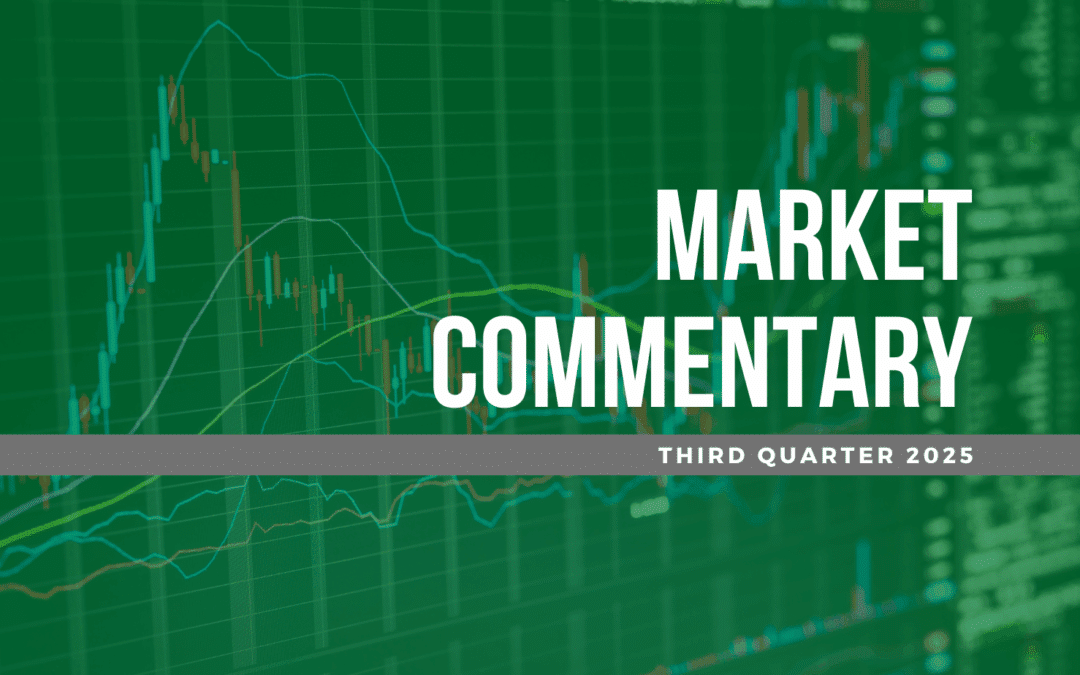July 3, 2025
Economic Overview
By Dr. Mark Pyles
How history ultimately judges the second quarter of 2025 remains uncertain, as one of the most economically significant events in recent memory continues to unfold. On April 2nd, which was dubbed “Liberation Day” by President Trump, a sweeping and unexpectedly steep tariff proposal was introduced, triggering significant economic and market uncertainty.
For context, the Smoot-Hawley Act of 1930 had marked the high point of modern tariff policy with average rates near 20%. Since the late 1940s, tariffs have generally declined, dropping to approximately 2.5%. President Trump’s initial proposal would have effectively increased that rate tenfold.

Dr. Mark K. Pyles
Director of Multi-Asset Strategies
Financial markets initially reacted sharply negatively, although sentiment improved over the remainder of the quarter. Admittedly, the initial salvo of tariff announcements was deemed a starting point for negotiations, and such talks are underway with many key partners such as China, Japan, and the European Union. Although these talks are a welcome sign of progress, it seems nearly certain that the ultimate final levels of tariffs on imported goods will remain significantly above those seen during decades of globalization.
While the long-term effects of tariffs remain widely debated, the near-term consensus is that they tend to slow economic activity and elevate prices. The most obvious direct economic impact from the recent surge in tariffs is upward pressure on prices within the U.S. economy. For context, when exiting the pandemic, amid a period of strong pent-up demand, supply chain snarls, and unprecedented fiscal stimulus, inflation soared. The Consumer Price Index (CPI) peaked above 9% year-over-year (YoY) in the summer of 2022 before rapidly declining to around 3% by mid-2023 and has continued to edge down more slowly since.
So far in 2025, the monthly headline CPI figure has averaged 2.6% YoY, with the latest May reading at 2.4%. Core CPI, which excludes the more volatile categories of food and energy, has held steady at 2.8% YoY for the past three months. Meanwhile, the Fed’s preferred inflation gauge, Core Personal Consumption Expenditures (PCE), registered 2.7% in its most recent reading.
While all of these figures remain above the Fed’s 2% target, they have yet to reflect the expected inflationary effects of recent tariff increases. The delayed impact likely stems from several factors. Many goods currently in the market were ordered or shipped before tariffs took effect. Additionally, companies may be deferring price hikes on pre-tariff inventory or temporarily absorbing increased costs while awaiting the outcome of negotiations.
That said, pricing pressures are likely to build. Tariffs are now affecting incoming goods, and businesses are unlikely to continue absorbing costs indefinitely. Baseline expectations are that inflation is near a short-term floor, with increased pressures expected through year-end. Supporting this, the “prices paid” component of the widely followed ISM Manufacturing Index has risen sharply in 2025, to above 65 compared to around 50 over the previous two years. Further, while the effects were very short-lived, the recent events surrounding the Israel/Iran war highlight how elements such as energy prices can be put under pressure given geopolitical issues beyond just tariff negotiations. Ultimately, while the extent and timing remain uncertain, at least marginally higher inflation appears increasingly likely.
The second anticipated consequence of significantly higher tariffs is a slowdown in economic activity, primarily driven by reduced demand. This drop in demand can stem from two main sources. First is the obvious impact of rising prices: consumers have limited purchasing power and are likely to reduce spending in aggregate with higher pricing pressures upon them. More critically, the considerable uncertainty surrounding the final scope of tariffs makes it difficult for individual consumers and businesses alike to commit to longer-term investments. This uncertainty can effectively paralyze economic decision-making. The sluggishness of activity within the current housing market perhaps speaks to this effect.
At present, we only have finalized first-quarter GDP data and early estimates for Q2 to evaluate the effects of the new tariff environment. The third estimate for Q1 GDP, released last week, showed a -0.5% quarter-over-quarter (QoQ) annualized contraction – marking the first quarterly decline since early 2022. However, this was heavily skewed by a sharp drop in net exports, driven by a 38% QoQ surge in imports as companies rushed to front-run tariff implementation. Much of this distortion is expected to reverse in Q2 data, as the Atlanta Fed’s current “nowcast” for Q2 GDP stands at 2.5%. The real view of economic activity probably lies somewhere in the middle. For example, a more demand-centric measure, Private Domestic Final Purchases (PDFP), rose 2.7% YoY in Q1 2025. This roughly matches its average over the past eight quarters and suggests demand remains resilient.
Still, there are emerging signs of weakness. Personal consumption, which comprises over two-thirds of GDP, hit its lowest level since COVID in Q1, at only +0.5%. Retail sales figures also declined in both April and May. Additionally, business and consumer sentiment, as captured across various surveys, continues to lean meaningfully negative. There are even high-frequency signs of consumer activity slowing down (such as less traffic through TSA checkpoints in airports and fewer consumers spending nights in hotel rooms) over the past several weeks.
Of course, concerns about a potential economic slowdown are nothing new. Each quarter since the pandemic has been accompanied by murmurs of an impending recession. Yet time and again, when the hard data arrives, those fears have been pushed aside—and a meaningful downturn has yet to take hold. The main driver of this ongoing resilience has been the strength of the labor market. Over 2022-2024, the U.S. economy added over 9M jobs to nonfarm payrolls, while the unemployment rate averaged 3.8% and hourly earnings grew at an average rate of 4% YoY. All of this in the face of seemingly relentless expectations for a slowdown.
That said, despite a track record of false alarms, there are once again emerging signs of job market stress as the economy navigates rising prices and an increasingly uncertain growth outlook. For the first half of 2025, the U.S. economy has added an average of 130k nonfarm payroll jobs per month, including a better-than-expected June report. However, this represents a notable slowdown from the average of 192k monthly job gains seen across 2023 and 2024. The unemployment rate, while still low at 4.1%, has increased by over half a percent since April of 2023. Initial jobless claims have trended higher, with the four-week moving average rising from 212k early in the year to over 240k currently. Even more concerning, continuing claims have increased significantly, from under 1.4 million at the end of 2022 to nearly 2 million today.
All of this brings us to a familiar point; one that has echoed throughout recent history. These are mixed signals. A close examination of hard economic data reveals emerging negative trends, while the current absolute levels remain far from alarming. As is often the case, trends seem to draw more attention than absolute values, particularly when the trend can explain the negative sentiment over the last several quarters.
This leads to the key question. Will these negative trends persist long enough to pull the actual data down to match the increasingly pessimistic sentiment, leading to a meaningful deterioration in economic conditions? While the trends certainly have our attention, our baseline outlook currently remains unchanged. We do expect the remainder of 2025 to be marked by slower economic growth and moderately higher inflation. However, we do not foresee these developments pushing the U.S. economy into recessionary territory and believe consumer demand and a solid labor market will continue to drive the U.S. economy forward – albeit against increasingly challenging headwinds.
The Stock Market
By Walter B. Todd, III
This year marks the notable anniversary of several great movies from my childhood. Jaws turns 50 in 2025 and Back to the Future turns 40. While Jaws kept me out of the ocean for several years, Back to the Future is the one I will always stop and watch if I’m channel surfing (much to the chagrin of my wife). It’s interesting for me to contemplate the idea of someone coming from the future and providing information about upcoming events that seems completely impossible to believe, e.g. Marty telling Doc (in 1955) that Ronald Reagan was the U.S. President in 1985. A laughable concept to Doc at the time.

Walter B. Todd, III
President, Chief Investment Officer
Similarly, if a visitor from today had traveled back to the beginning of this year and said to me then – “Walter, we are going to get the largest increase in tariffs in 100 years and the U.S. is going to bomb Iran and the stock market will be at all-time highs and oil will go down,” I would have laughed similar to Doc. I may have even said something sarcastically like “the next thing you’re going to tell me is international markets are beating the U.S.” – Oh wait a minute. Let’s get back in the DeLorean now to 2025 and take a deeper dive into the numbers for the second quarter and YTD.
The S&P 500 finished on a tear, closing up +10.9% for the quarter, including dividends, ending the quarter at a new all-time high and +6.2% YTD. Looking beyond the U.S. large-cap space, small-cap stocks (as measured by the S&P 600) were also positive but finished a more modest +4.9% higher. Small-caps still remain negative through the first six months of 2025, down -4.5% YTD. Performance outside the U.S. continued to be strong with Developed International Markets rising +12.0% for the quarter (as measured by the EAFE Index) while Emerging Markets (EM) posted a similar gain of +12.2% for the period (measured by the MSCI Emerging Market Index). Year-to-date, these geographies are up +19.9% and +15.5%, respectively. Putting the U.S. and International Markets together, the MSCI All-Country World Index (ACWI) finished higher by +11.7% for the quarter and is up +10.3% YTD.
From a sector perspective, 8 of 11 sectors were actually positive for the period while only 4 of 11 outperformed the broader market (S&P 500). Sector leadership completely reversed from 1Q as the markets V-shaped recovery unfolded from the lows of early April, looking very much like the 2023 and 2024 backdrop. That is to say, the “Big 3” of Technology (+23.8%), Communication Services (+18.4%) and Consumer Discretionary (+11.5%) led the way (after being in last place in 1Q). Industrials were also a leader for the period, rising +13.0%. The top 5 was rounded out by Financials rising a healthy, but much lower, +5.5%. Despite a volatile geopolitical backdrop in the Middle East, Energy was the worst performing sector for the three-month period, falling -8.6% as oil failed to hold any gains. Real Estate (-0.1%) and Healthcare (-7.2%) were also negative as equity investors moved to risk through May and June. For the YTD period through June 30, 2025, 9 of 11 sectors were green with 6 of 11 outperforming the broader market. Industrials (+12.7%) and Communication Services (+11.1%) took the top 2 spots for the first six months, followed by Utilities (+9.4%), Financials (+9.2%) and Technology (+8.1%). Energy (+0.8%), Healthcare (-1.1%) and Consumer Discretionary (-3.9%) brought up the rear. Interestingly, in the first few days of July, we have seen yet another rotation in leadership to some of the laggards in Energy and Materials. We’ll see what the rest of the summer holds. No doubt there will be some surprises in store.
As the market recovered from the early April lows, the A.I. trade reemerged as leadership, causing yet another quarter of mega-cap and technology outperformance. As a result, from a factor standpoint, we witnessed a large relative outperformance of Growth over Value, while Size and Volatility were also positive. While not necessarily a favorable backdrop for our strategies, stock selection provided a strong tailwind to the absolute and relative performance in our Large-cap and SMID (small and mid-cap) strategies. The Dividends and Value factors were negative for the period; however, our Dividend & Income strategy was able to outperform thanks to a more diversified sector allocation. Finally, our International ETF portfolio performed in-line with the positive returns outside the U.S.
The rollercoaster ride for equity markets over the past three months probably feels a bit like hitting 88 miles per hour in the time machine (built out of the DeLorean) – jarring and disorienting. At the lows on April 7, the S&P 500 was down nearly 18% for the year and down 15% in three days. “Great Scott!” as Doc would say. While not surprised to see the market rebound from these oversold levels, I would certainly not have predicted a move to new highs in less than 60 days. A positive development to be sure, but perhaps extended in the short term, creating the risk for a corrective move lower should earnings or data disappoint in the coming weeks and months. We continue to look for relative value in the market while also monitoring exposures to areas and names that have run aggressively over the past several months.
The Bond Market
By John D. Wiseman
Bond yields were higher to start the quarter as “Liberation Day” and the initial tariff announcements raised concerns of a Federal Reserve that would need to be more vigilant against higher inflation expectations. This happened at a time when U.S. equity markets were under pressure – a clear sign that investors sought safety away from the U.S. for the first time in many years. The 10-Year Treasury Note finished the quarter with a yield of 4.23%, which was little changed for the second quarter period, but 34 basis points lower since the start of the year. This equates to a total return of 0.98% and 5.03% for the quarter and the year, respectively.

John D. Wiseman
Director of Fixed Income
The yield on the 2-Year Treasury Note was lower by 16 basis points for the quarter to 3.72% producing a total return of 1.11%. Its yield is sharply lower than at the start of the year (52 basis points), which results in a total return of 2.68% given the short duration of that bond. Continued concern around the level of U.S. debt and forecasted fiscal deficits has steepened the yield curve to its widest level in over three years as measured by the 2-year and 10-year maturities.
The tariff announcement on April 2 shocked the corporate bond market. There were a few days in early April when bond trading seized up. This likely prompted the extension of the tariff deadline just a few days later. With a three-month reprieve, markets reopened, and corporate bond spreads rallied. The quarterly total return, as measured by the Bloomberg Intermediate Corporate Index, was 2.12%. This takes the performance for the first half of the year to a healthy 4.45%. The yield spread over Treasuries of the Bloomberg Intermediate Corporate Index narrowed near the level where it began the year at 75 basis points resulting in an overall yield of 4.66%. Investment-grade corporations issued $980 billion of debt during the first half of the year – a 7% increase over last year as demand remains strong for new issues. Bonds of lower-rated companies were the best performers of the quarter. There was significant weakness in the high yield sector to start the year, so this outperformance only brings them in-line with their investment-grade peers for the year. Volatility in this space should provide opportunities to add high quality corporate bonds to the portfolio.
Municipal bonds had their best six-month start to a year since 2020. The Bloomberg 5-Year Municipal Index ended the quarter with a yield of 2.71%. This is 20 basis points lower than at the start of the year and resulted in total returns of 1.35% and 2.27% for the quarter and year, respectively. The yield ratio to Treasuries (a measure of relative value) is 71%. Demand for municipal bonds is expected to remain high though issuance has been robust – on pace to be 18% higher than last year. Overall yields remain attractive for individuals in the higher tax brackets. We are watching for any effects of updated tax policy from Washington. Currently, tax receipts exceed expectations and municipalities are in good financial shape, broadly speaking.
Yields of mid-maturity bonds are near their low points of the year, which has been beneficial to our performance. We will continue to look for opportunities to extend some of these to increase overall portfolio yield. Further, corporate bonds have returned to tighter spread levels after the volatility associated with the initial tariff announcement. We remain overweight in high quality corporate bonds though less so than at the beginning of the year. We expect continued volatility around tariff and public policy announcements.
The information contained within has been obtained from sources believed to be reliable but cannot be guaranteed for accuracy. The opinions expressed are subject to change from time to time and do not constitute a recommendation to purchase or sell any security nor to engage in any particular investment strategy. Investment Advisory Services are offered through Greenwood Capital Associates, LLC, an SEC-registered investment advisor.










